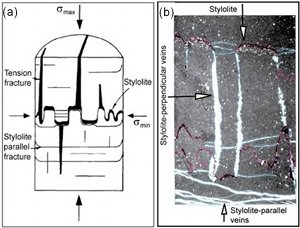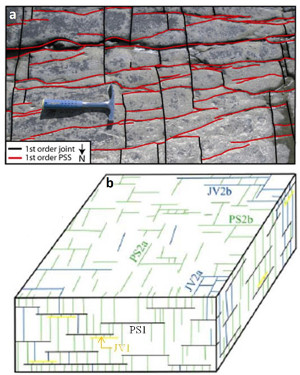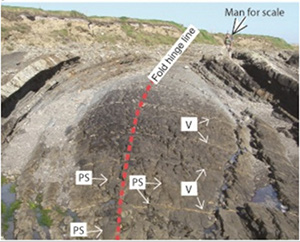| |||||||
|
|
|||||||
|
|
|||||||
| Assemblages of Joints / Veins and Pressure Solution Seams | |||||||
|
Pressure solution seams and joints or veins which have opposite sense of kinematics are commonly observed to be associated in deformed rocks (Figures 1, 2, and 3). They often occur either at right angle to each other (Figure 1a) or parallel to each other (Figure 1b). Individual veins vary in length and often have wedge-shaped terminations at pressure solution seams at their wider end (Figures 1a and 2a). Based on the mutually abutting intersection geometry in both 2D (Figure 2a) and 3D (Figure 2b), these structures are thought to be contemporaneous and are likely formed under a particular remote state of stress (Nelson, 1981; Nenna and Aydin, 2011). However, various other factors play a role in this association besides the remote stresses (Zhou and Aydin, 2012) as discussed under 'Mechanisms and Mechanics of Fracture Assemblages.'
Perhaps the occurrence of these assemblages in folded rocks (Figure 3) is most revealing because one set of pressure solution seams is generally parallel the fold hinge line and hence formed perpendicular to the greatest compression responsible for the fold, while the vein set is perpendicular to the fold hinge line and is sometimes attributed to fold axis parallel extension (Nelson, 1981), a phenomenon usually observed in the so-called triaxial extension tests in the laboratory. The most general case of assemblage includes three mutually orthogonal pressure solution seam sets and three joint or vein sets as illustrated in a schematic diagram in Figure 2b based on detailed mapping in platform carbonate rocks exposed along the Apennines in eastern Italy (Agosta and Aydin, 2006). The table in 'Mechanisms and Mechanics of Fracture Assemblages' summarizes conditions responsible for the resulting combinations of fracture types. Interested readers are referred to the original publication for the details. Non-orthogonal pressure solution seams and veins are also common and are generally associated with shearing of one member or the other and will be reconsidered under 'Assemblages of Joints / Veins, Pressure Solution Seams, and Faults' and 'Faulting by Shearing of PSS and Vein Assemblages.' Additional details can be found in Rispoli (1981), Petit and Mattahauer (1995), Peacock and Sanderson (1995), Willemse et al. (1997), Graham et al. (2006), Watkinson and Ward (2006), and Agosta and Aydin (2006). | |||||||
| Reference: |
|||||||
| Agosta, F., Aydin, A., 2006 Graham Wall, B., Girbacea, R., Mesonjesi, A., Aydin, A., 2003 Nelson, R.A., 1981 Nenna, F., Aydin, A., 2011 Peacock, D.C.P., Sanderson, D.J., 1995 Petit, J.P., Mattauer, M., 1995 Rispoli, R., 1981 Wall, B.R.G., Girbacea, R., Mesonjesi, A., Aydin, A., 2006 Watkinson, A.J., Ward, E.M.G., 2006 Willemse, E.J.M, Peacock, D.C.P., Aydin, A., 1997 Zhou, X., Aydin, A., 2012 |
|||||||
|
Readme | About Us | Acknowledgement | How to Cite | Terms of Use | Ⓒ Rock Fracture Knowledgebase |
|||||||


